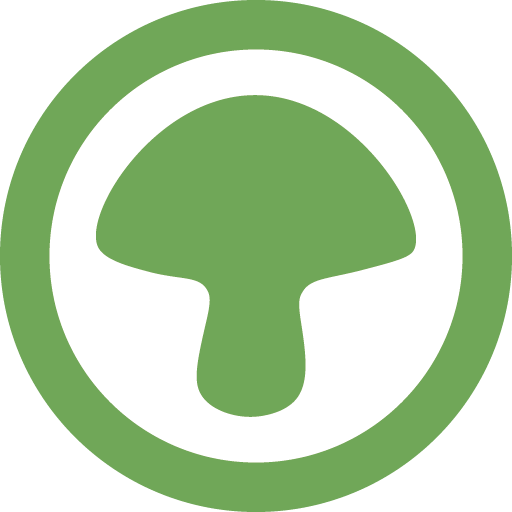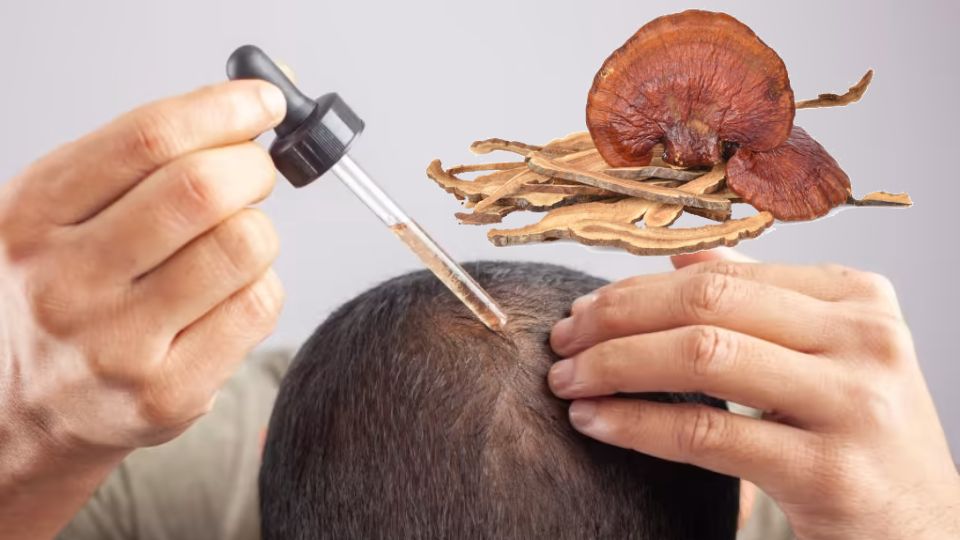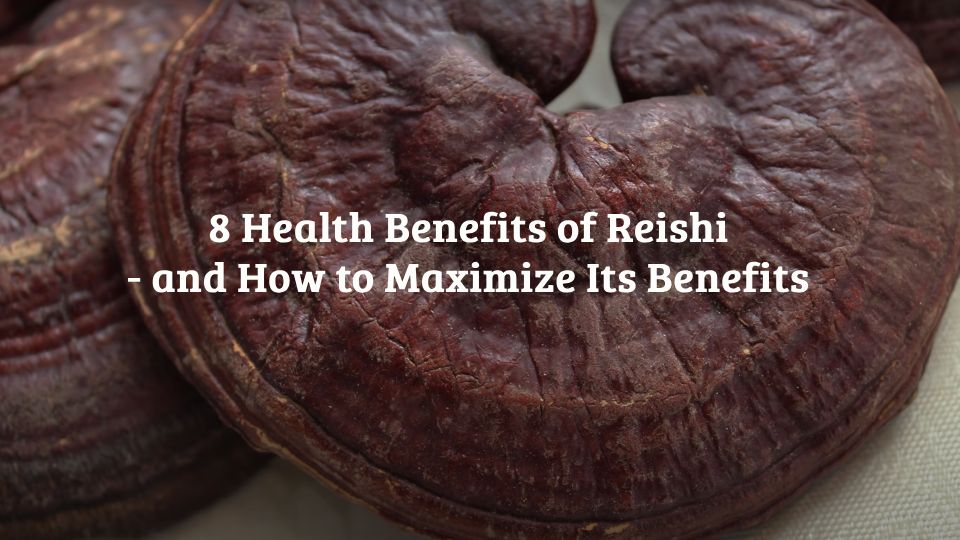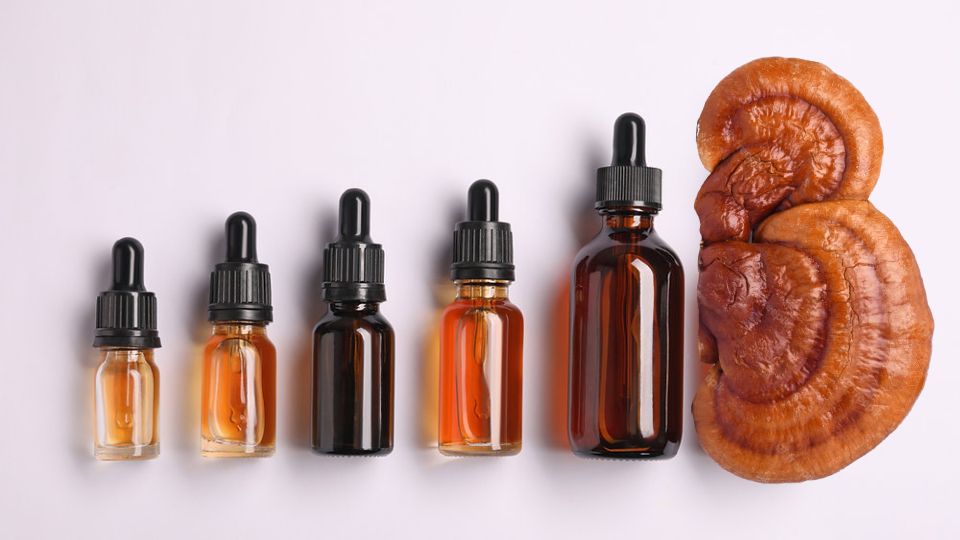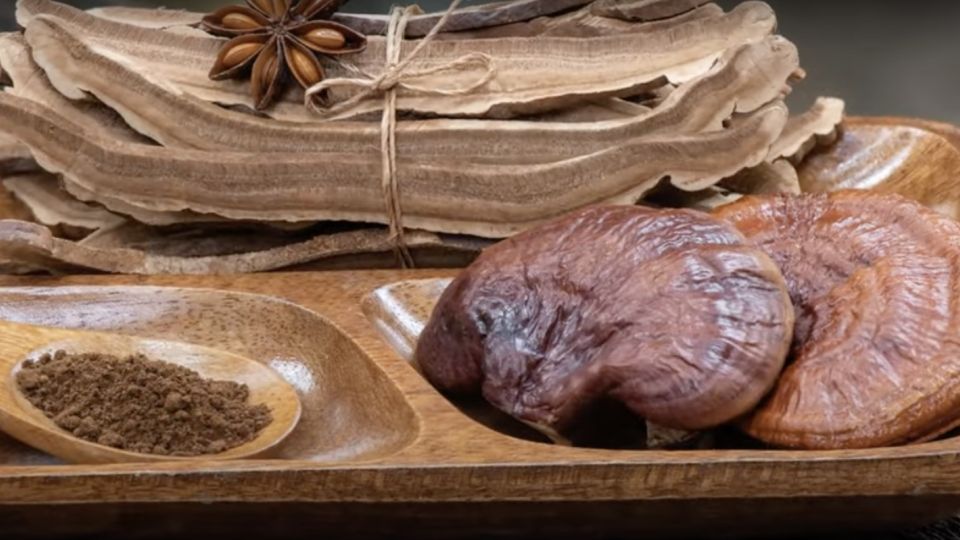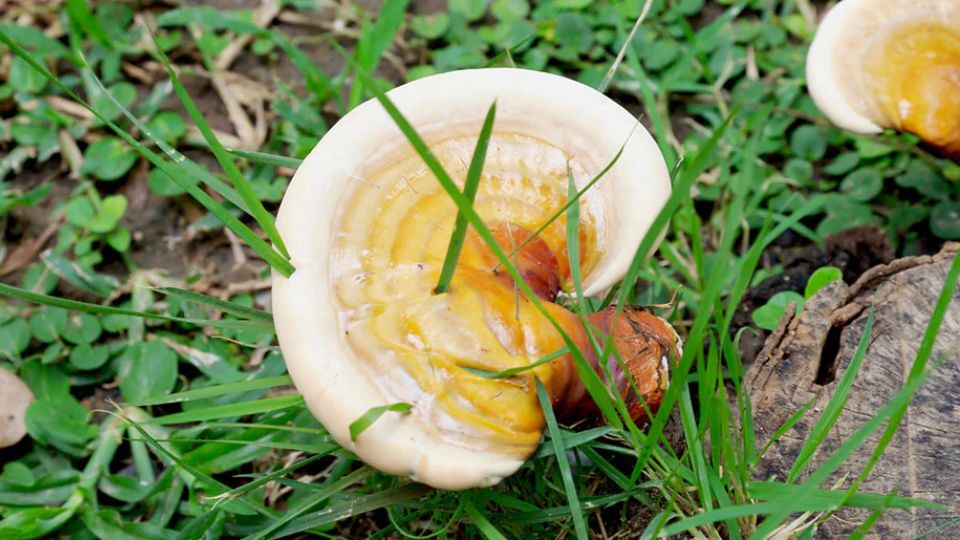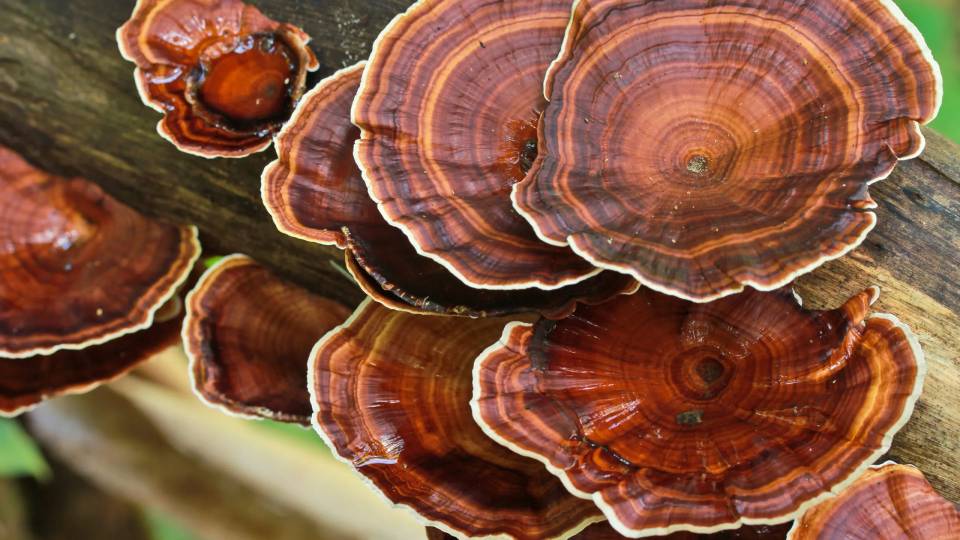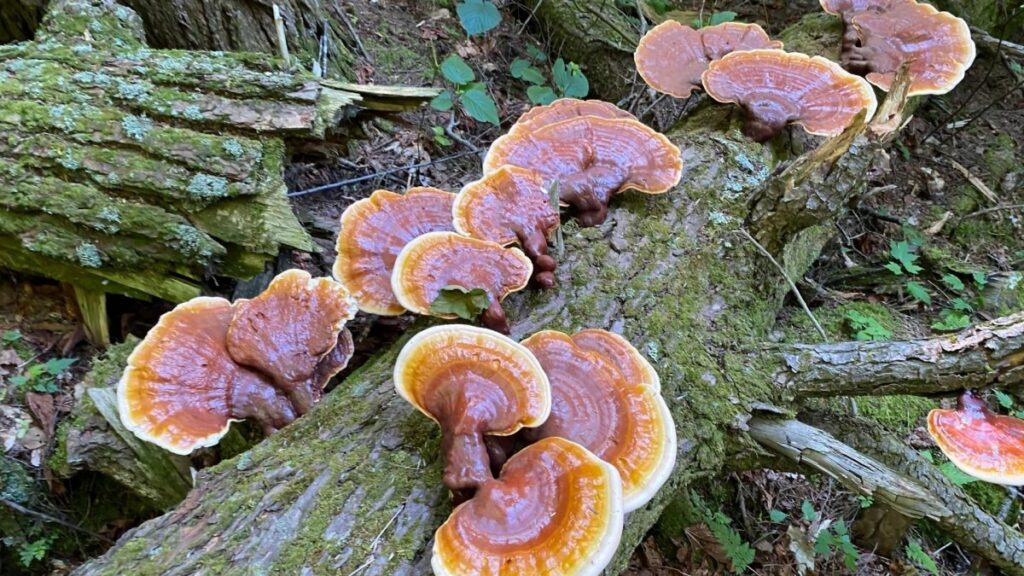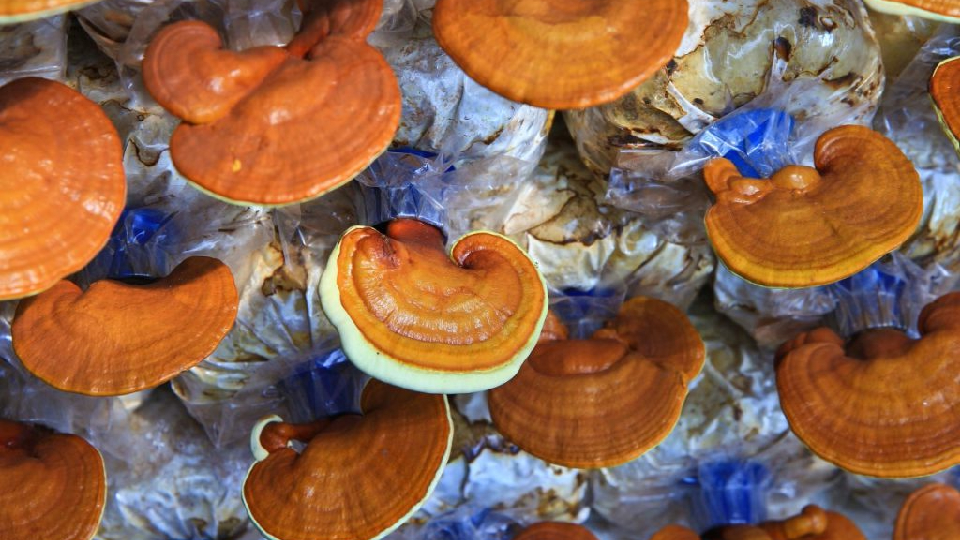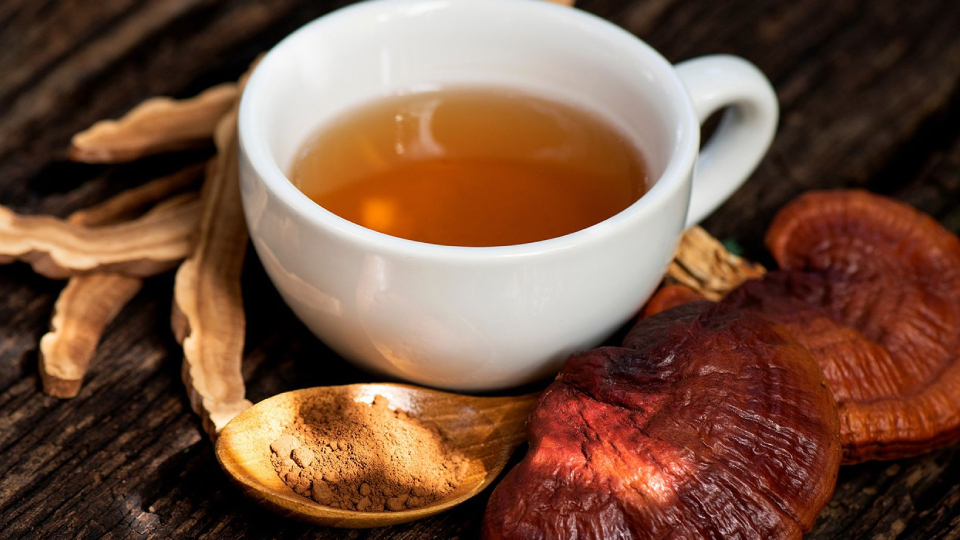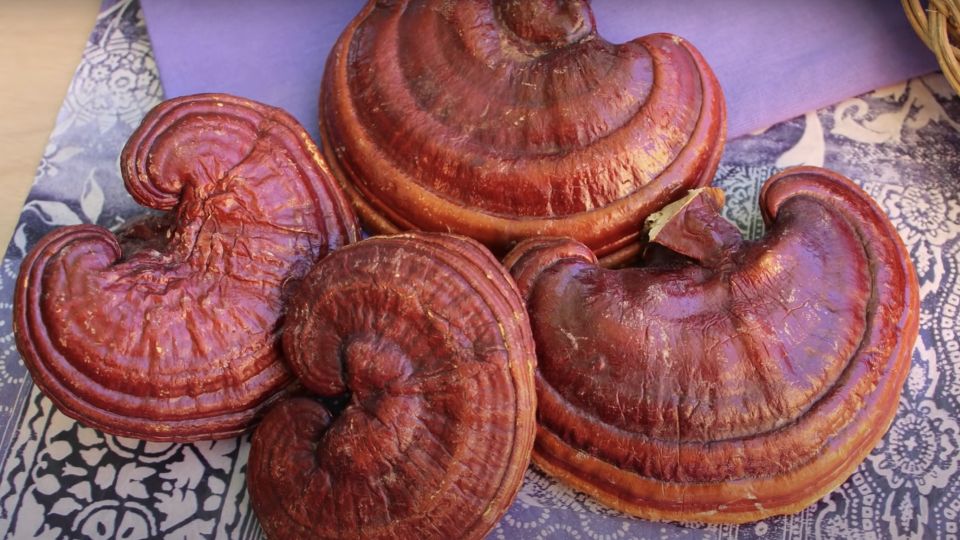
Reishi Mushrooms: A Complete Guide
Reishi mushrooms, scientifically known as Ganoderma lucidum and called Ling Zhi (灵芝) in Chinese, have a rich history of use in traditional Chinese and Japanese medicine. Recent research reveals their numerous health benefits, including anti-inflammatory, antioxidant, immunomodulatory, and anti-tumor properties. They also show promise in supporting cardiovascular health, liver protection, cognitive enhancement, and potential use in treating mental health issues like anxiety and depression. Incorporating Reishi mushrooms into your diet can promote overall health by harnessing these benefits, as suggested by recent research.
How to Identify Reishi
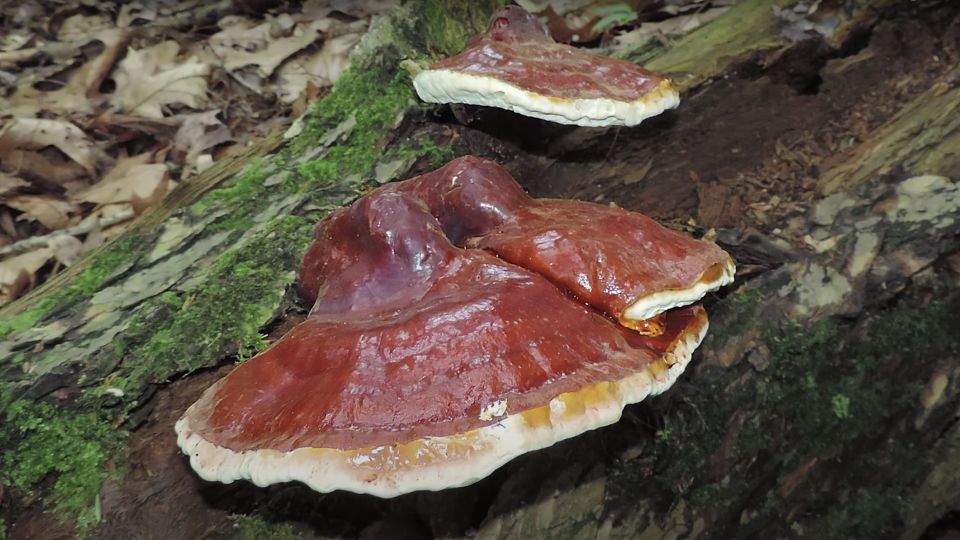
These mushrooms are typically found in hardwood forests and are characterized by a reddish-brown, fan-shaped cap that can range from 2-12 inches in diameter. To identify them, observe their distinct physical features: smooth, reddish-brown caps, white gills underneath (which may be curved or straight), and tough, white stems measuring about one inch in thickness with a white ring around the base.
Look for firm caps with a varnished appearance and white gills that may darken over time. Additionally, examine the white stems adorned with a thin white ring near the base. With practice, you’ll confidently distinguish these unique mushrooms.
History of Reishi
The history of Reishi mushrooms is deeply rooted in traditional Chinese medicine, dating back over 2,000 years. In ancient times, these mushrooms were so highly prized that they were often referred to as the “elixir of life,” and only royalty and emperors could obtain them.
Chinese medical texts like the Ben Cao Gang Mu and the Shen Nong Ben Cao Jing describe Reishi mushrooms as having a wide range of medicinal properties, including potent anti-inflammatory, antioxidant, and immune-modulating effects. They were used for centuries as a tonic herb to promote longevity, and vitality, and to treat various ailments[1].
Their rarity and high value made them symbols of wealth, power, and good fortune. Chinese emperors believed that consuming Reishi would grant them a long and prosperous life, which is why these mushrooms were reserved for the elite. Today, they remain highly valued for their numerous health benefits and are readily available as supplements, teas, and in various forms.
“Reishi mushrooms contain a diverse array of polysaccharides, triterpenoids, and other bioactive compounds that have been shown to have immunomodulatory, anti-inflammatory, and anti-tumor properties.”
– Paul Stamets, Mycologist
Health Benefits of Reishi
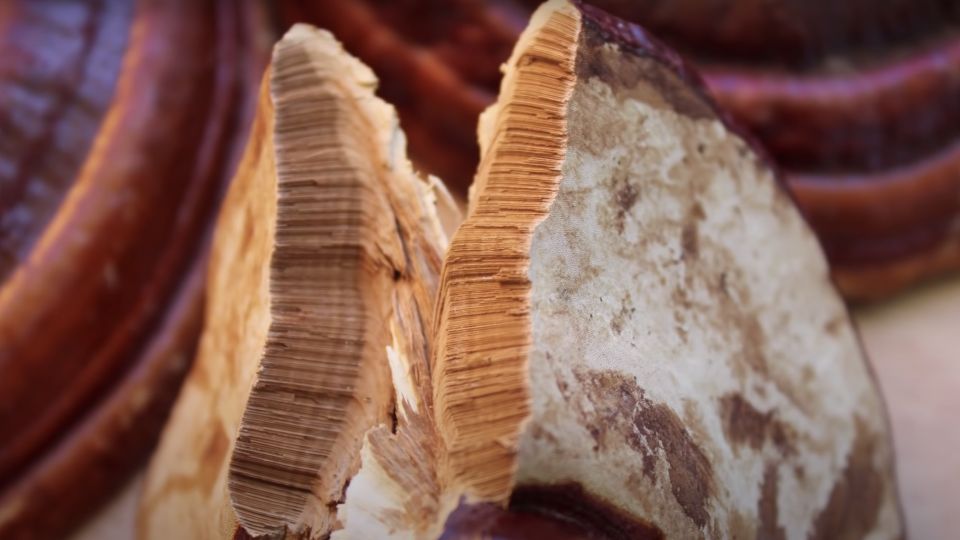
Reishi mushrooms have undergone extensive research for their therapeutic potential, with a focus on immune system function, cancer treatment, and cardiovascular health. A study in the Journal of Ethnopharmacology revealed that these mushrooms enhanced the immune response in human subjects by increasing levels of natural killer cells and T lymphocytes[2].
Other research suggests anti-cancer properties, including inhibiting tumor growth and reducing inflammation[3]. Additionally, Reishi mushrooms positively impact cardiovascular health, leading to reduced blood pressure and cholesterol levels[4]. Clinical studies have also demonstrated their significant effects on blood sugar levels, making them an effective treatment option for individuals with diabetes.
As mycologist Christopher Hobbs explains, “Reishi mushrooms are adaptogens, which means they help the body to adapt to stressors and maintain homeostasis.”
Its Medical Compounds and Benefits
| Compound Name | Description | Potential Health Benefits |
|---|---|---|
| Beta-Glucans | Polysaccharides that boost immune function | Enhanced immune system support, anti-inflammatory effects |
| Triterpenes | Ganoderic acids with anti-inflammatory properties | Liver protection, potential cancer-fighting properties |
| Ergosterol | A precursor to vitamin D | Promotes bone health, aids in calcium absorption |
| Polysaccharides | Complex carbohydrates | Immune system modulation, potential antitumor effects |
| Adenosine | A nucleoside with various physiological effects | Blood pressure regulation, potential anti-anxiety benefits |
| Ganodermanontriol | A compound with antioxidant properties | Protection against oxidative stress, immune system support |
| Linoleic Acid | A polyunsaturated fatty acid | Cardiovascular health, skin health, anti-inflammatory effects |
| Triterpene Sterols | Compounds with potential cholesterol-lowering effects | Cardiovascular health, cholesterol regulation |
| Ganoderenic Acid | A compound with anti-allergic properties | Allergy relief, potential asthma management |
| Polysaccharide Peptides | Complex molecules with immunomodulatory effects | Immune system enhancement, potential antitumor effects |
| Ganoderiol F | A triterpene with anti-inflammatory properties | Potential pain relief, anti-inflammatory effects |
Reishi Mushrooms Uses
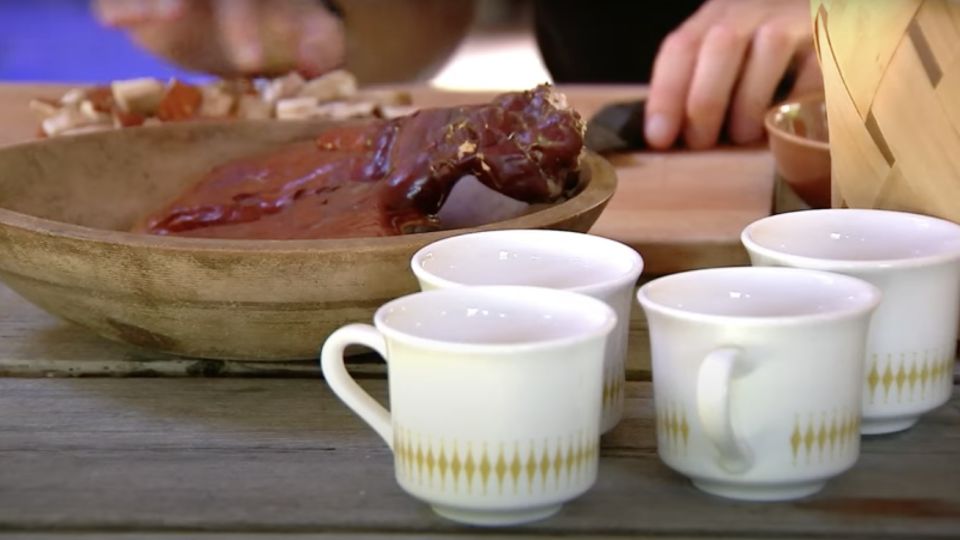
You might love many aspects of reishi mushrooms, but their texture could be a bit challenging. They’re dense and tough, making it a bit tricky to eat them. However, they’re not impossible to enjoy. In fact, their slightly bitter taste pairs wonderfully with beverages and desserts. Consuming reishi mushrooms through tinctures and extracts is also quite straightforward. Let’s explore the best ways for you to consume reishi mushrooms to make the most of their incredible potential benefits.
1. Brew Reishi Tea
To enjoy the Queen of Mushrooms in your tea, try our favorite Reishi Mushroom Tea recipe. Whether you’re looking to start your day with a sense of balance or wind down for a restful night, this tea has you covered.
Here’s what you’ll need: reishi mushrooms, water, a pot, and a stove. If you have a slow cooker, that’s even better! Start with fresh fruiting bodies, whether you purchased them or foraged. Begin by boiling a 1-inch piece of dried reishi mushroom with water, adding a touch of honey and a lemon wedge for flavor. And if you’re feeling adventurous, feel free to customize your tea with other natural flavors.
2. Enjoy Reishi Mushrooms in Tasty Creations
If you’re a fan of bold flavors like those found in coffee and dark chocolate, you’ll likely appreciate the slightly bitter taste of reishi mushrooms. Many even dub reishi as the “chocolate lover’s mushroom” because of its resemblance to dark chocolate in terms of flavor.
This bitterness in reishi mushrooms comes from triterpenes, compounds that can potentially support various functions in your body, including brain health and immune system strength. These triterpenes not only offer numerous health benefits but also blend seamlessly into a wide range of dishes featured in this Reishi Recipe Blog Post.
You can easily incorporate reishi powder into your favorite smoothies, juices, and healthy desserts, making it a delightful addition to kickstart your day with a touch of sweetness.
3. Explore Reishi Extracts and Tinctures
To make the most of the valuable active compounds locked within reishi mushrooms’ tough cell walls, you’ll need to extract them. This is where reishi mushroom extracts and tinctures come into play, offering a wonderful solution.
You can effortlessly incorporate these extracts and tinctures into your preferred dishes. By doing so, you’ll be able to enjoy the full spectrum of support that reishi mushrooms provide.
4. Make Reishi Coffee
You know, Reishi mushrooms, according to traditional Chinese herbalism, have quite a reputation for balancing your spirit and potentially improving your sleep. When you include them in your daily routine, try our favorite ganoderma coffee, you might just find yourself gradually feeling more energized. What’s great about this coffee is its versatility. It’s got your back whether you want to start your day feeling balanced or give your energy a boost in the afternoon.
Here’s the deal: All you need are the right ingredients – Reishi mushroom extract, your favorite coffee, water, a reliable coffee maker, and a stove. Start with the Reishi extract powder or tincture. Then, just make your usual cup of coffee and mix in the Reishi extract. If the taste is a tad bitter for your taste, no worries. You can sweeten it up with honey or make it creamier with your milk of choice.
Dosages
When it comes to reishi mushrooms, the dose can differ based on the type you use. Typically, people opt for dried mushroom extract, which requires about one-tenth of the dose compared to consuming the whole mushroom.
For instance, if you were to have 50 grams (g) of the actual reishi mushroom, it would be roughly equivalent to 5 g of mushroom extract. The recommended daily doses for the extract can vary but generally fall within the range of 1.5–9 g.
It’s worth noting that some supplements use specific parts of the extract, resulting in lower recommended doses compared to what’s mentioned above.
Side Effects
The compounds present in reishi mushrooms, including polysaccharides, triterpenes, and peptidoglycans, can have various effects on the body and may cause adverse reactions such as allergies, digestive issues, and headaches. Therefore, it’s important to exercise caution when consuming them.
Individuals with allergies should be especially careful when consuming these mushrooms. Allergic reactions can result in skin rashes, breathing difficulties, and even anaphylaxis[6].
Moreover, they can lead to digestive issues like nausea, vomiting, and diarrhea, which can be severe enough to cause dehydration. It’s advisable to consult with a doctor before taking reishi mushrooms if you have pre-existing digestive issues.
In some cases, people may experience headaches, and researchers suggest that the triterpenes found in the mushrooms may be responsible. If you experience headaches after consuming them, it’s best to stop taking them and seek advice from your doctor.
Interactions
- For Diabetes Medications (Antidiabetes drugs): Reishi mushroom can potentially lower your blood sugar levels. When you’re taking reishi mushroom alongside your diabetes medications, be vigilant about monitoring your blood sugar. It’s possible for it to drop too low.
- For High Blood Pressure Medications (Antihypertensive drugs): Reishi mushroom has the potential to reduce your blood pressure. If you’re using Reishi mushroom alongside blood pressure medications, keep a close eye on your blood pressure levels. There’s a chance it could drop too low.
- For Blood Clotting Medications (Anticoagulant / Antiplatelet drugs): Reishi mushroom might slow down your blood clotting process. When you’re on medications that also slow blood clotting, combining them with reishi mushroom could increase the risk of bruising and bleeding. Be cautious in this regard.
Reishi Mushrooms Cultivation And Harvesting
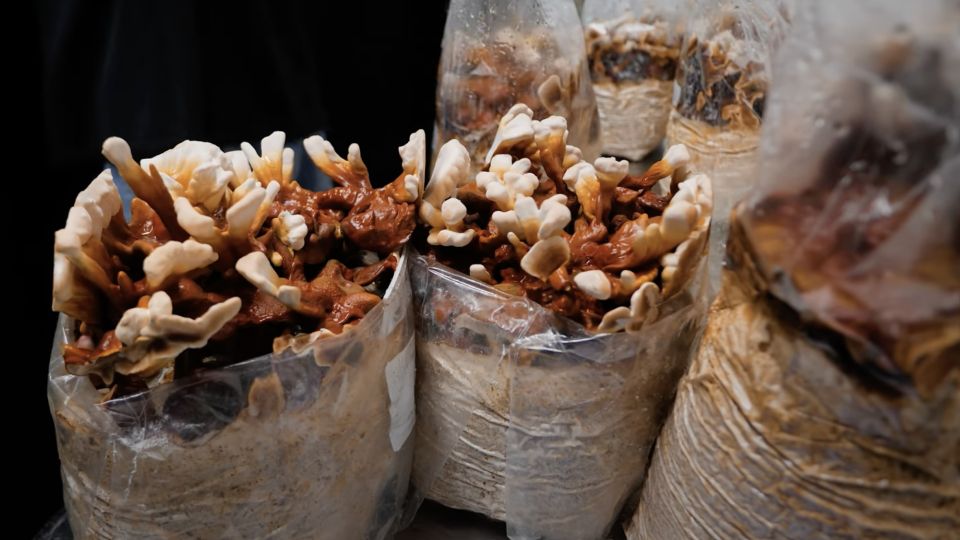
Growing your own Reishi mushrooms at home can be an exciting and rewarding experience. Here are some interesting facts and tips to consider:
- Choose Your Growing Method: You can grow reishi mushrooms indoors or outdoors, using various containers like jars, buckets, bags, logs, or fruiting blocks. Decide based on your space, resources, and desired yield.
- Gather Necessary Supplies: Collect the required materials for growing reishi mushrooms, including mushroom spawn, containers, suitable substrate (like supplemented sawdust), and the right growing environment.
- Prepare the Substrate: Reishi mushrooms prefer nutrient-rich substrates, unlike some other mushrooms. Consider using supplemented sawdust or a similar substrate to create an ideal, moist environment for growth.
- Inoculate the Substrate: Follow the spawn instructions to introduce it to the substrate. This allows the mycelium to spread throughout the medium.
- Provide Optimal Conditions: Maintain the correct temperature and humidity levels to support healthy reishi mushroom growth. Monitor and adjust these conditions as needed.
- Care for the Mushrooms: Keep a close eye on your growing mushrooms. Watch their progress, make any necessary environmental adjustments, and guard against potential infections or contaminants.
- Harvesting: Reishi mushrooms are ready when the cap margin turns from white to red. Cut or twist them at the stem base, but be cautious as they can be tough to harvest.
- Drying and Storage: Reishi mushrooms spoil quickly unless dried promptly. Thoroughly dry them to maintain quality and extend their shelf life. Store dried mushrooms in a cool, dry place in an airtight container.
These mushrooms require specific environmental conditions, such as high humidity levels of 80-90% and temperatures around 77-82°F (25-28°C). They also require indirect or low light for optimal growth[7].
Final Thought
Incorporating reishi mushrooms into your daily routine can be a valuable addition to your wellness regimen. Whether consumed as a supplement, brewed into tea, or added to recipes, they offer a convenient way to tap into their myriad health-promoting properties. Additionally, you can take reishi mushrooms with other medicinal mushrooms such as lion’s mane, cordyceps, and chaga.
However, it’s important to remember that while reishi mushrooms hold promise, they’re not a magical cure-all. As with any supplement or natural remedy, it’s crucial to maintain a balanced diet and lifestyle for optimal health outcomes.
Ultimate Guide to the Reishi Mushrooms
Our detailed walkthroughs will assist you in exploring the potential of Reishi, providing you with in-depth knowledge.
- Reishi Mushroom Benefits for HairReishi Mushroom Benefits for Hair: A Comprehensive Guide The Reishi mushroom, known as Ganoderma lucidum or Lingzhi, holds a rich history in Asia, often been … Read more
- Reishi Mushroom Benefits8 Health Benefits of Reishi Mushroom Reishi, the “mushroom of mortality,” has been celebrated in Chinese medicine for over 4,000 years. You might be wondering … Read more
- Reishi TinctureReishi Tincture: How to Make it and Its Benefits In the world of natural remedies and dietary supplements, there’s a rising star that has captured … Read more
- Best Reishi Mushroom SupplementsThe Best Reishi Mushroom Supplements of 2025 (Our Top 3 Picks) In a world constantly in pursuit of wellness and vitality, nature has consistently offered … Read more
- Reishi Mushroom for SleepReishi Mushroom for Sleep: Nature’s Sleep Aid In a fast-paced world where sleep often takes a back seat, millions of people are on a quest … Read more
- How to Dry Reishi MushroomHow to Dry Reishi Mushroom (3 Ways) If you’re a forager lucky enough to stumble upon some Reishi mushrooms, it’s essential to note that they’re … Read more
- Ganoderma curtisiiGanoderma Curtisii (Golden Reishi): Identification, Benefits, and Uses Ganoderma curtisii is a captivating mushroom that has fascinated mycologists and enthusiasts around the globe. Its name … Read more
- Ganoderma CoffeeGanoderma Coffee (Reishi Coffee) Reviews Have you heard of Ganoderma coffee “Reishi coffee”? This unique blend has been gaining popularity in recent years, capturing the … Read more
- How Long Does It Take for Reishi Mushroom to WorkHow Long Does It Take for Reishi Mushroom to Work? Are you curious about the effectiveness of reishi mushrooms and how long they take to … Read more
- Reishi Mushroom PsychedelicReishi Mushroom Psychedelic Effects on the Brain Unlike certain mushrooms renowned for their psychedelic properties, reishi mushrooms do not cause hallucinations or alter one’s mental … Read more
- Reishi Mushroom Benefits for SkinReishi Mushroom Benefits for Skin: Unlocking Nature’s Secrets Reishi Mushroom Benefits for Skin are often discovered by enthusiasts exploring the world of medicinal mushrooms. These … Read more
- Reishi Mushroom Look AlikesReishi Mushroom Look-Alikes: Identification and Forage Guide The unique features of Reishi mushrooms include a reddish-brown or black cap with a shiny or matte texture, … Read more
- Reishi Mushroom GrowingReishi Mushroom Growing: A Comprehensive Guide Growing your own Reishi mushrooms can be fulfilling, and it is also a cost-effective way to enjoy the benefits … Read more
- Reishi Mushroom TeaReishi Mushroom Tea: 4 Key Health Benefits and How to Make It Reishi tea, also known as Ganoderma lucidum tea, is gaining popularity for its … Read more
References
1. A brief overview of the potential health benefits of Ganoderma lucidum. Retrieved from https://www.researchgate.net/publication/348135206_A_brief_overview_of_the_potential_health_benefits_of_Ganoderma_lucidum
2. Liu, C. C., Lin, C. C., Hsu, C. H., Chu, Y. L., & Chen, C. F. (2006). Immune enhancement of polysaccharide-protein complex isolated from Ganoderma lucidum in human subjects. Journal of Ethnopharmacology, 103(3), 448-454. Retrieved from https://www.ncbi.nlm.nih.gov/pubmed/16487479
3. The study is called “Inhibition of Tumor Growth and Metastasis by Ganoderma Lucidum (Reishi Mushroom) and Its Clinical Potential” Retrieved from https://www.researchgate.net/publication/235883045_Anti-Tumor_Effects_of_Ganoderma_lucidum_Reishi_in_Inflammatory_Breast_Cancer_in_In_Vivo_and_In_Vitro_Models
4. Hou, D. L., et al. (2018). The effects of Ganoderma lucidum (Reishi mushroom) on cardiovascular risk factors: A systematic review and meta-analysis of randomized controlled trials. Phytotherapy Research, 32(7), 1315-1325. Retrieved from https://onlinelibrary.wiley.com/doi/abs/10.1002/ptr.6067
5. Effects of Powder, Extracts, and Components of Ganoderma Lucidum in Treatment of Diabetes. Retrieved from https://www.researchgate.net/publication/352651539_Effects_of_Powder_Extracts_and_Components_of_Ganoderma_Lucidum_in_Treatment_of_Diabetes
6. Studies on Ganoderma lucidum. I. Efficacy against Hypertension and Side Effects. Retrieved from https://www.researchgate.net/publication/19068043_Studies_on_Ganoderma_lucidum_I_Efficacy_against_Hypertension_and_Side_Effects
7. Cultivation Technology of the Fungus Ganoderma lucidum (Curtis) P. Karst. Retrieved from https://www.researchgate.net/publication/359317900_Cultivation_Technology_of_the_Fungus_Ganoderma_lucidum_Curtis_P_Karst
